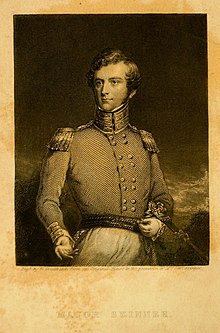Thomas Skinner (British Army officer, died 1843)

Thomas Skinner (1800? – 1843), was a British soldier and author. He commanded the 31st Foot in the First Anglo-Afghan War in 1842 and 1843. While there he was made a C.B. and brevet lieutenant-colonel. In 1832 he had published Excursions in India and four years later Adventures during a Journey Overland to India. [1]
Life
[edit]Born about 1800, he was son of Lieutenant-general John Skinner. He entered the army on 25 January 1816 as an ensign in the 16th Foot; he became lieutenant on 6 August 1819, captain on 9 October 1823, and exchanged into the 31st Foot on 25 March 1824.[1]
Skinner went with his regiment to India shortly before 1826, [2] on the voyage he was a witness to the Kent ship disaster.
He was stationed at Hardwar, in the North-West provinces, near the foot of the Himalayas. He made expeditions into little-known mountainous districts, and wrote up his explorations in Excursions in India (London, 1832). After returning home on leave, he went back to India in 1833 by the overland route through Egypt, Syria, and Palestine. He travelled down the Euphrates, and embarked on the Persian Gulf. He published an account of this journey in Adventures during a Journey Overland to India (London, 1836).[1]
On 24 November 1835 Skinner attained the rank of major, and in 1842 he joined the force assembled at Jalalabad under Sir George Pollock for the relief of Kabul. He commanded the 31st Foot in the campaign, and on 26 July 1842 was present at the conflict of Mazeena, near Jalalabad. He accompanied Pollock's advance, and was given the task of clearing the hills on the left of the valley of Tezin in the engagement there on 13 September.[1]
Skinner received for his services the Cross of the Order of the Bath and the Cabul medal, and was gazetted on 23 December to the brevet rank of lieutenant-colonel. He died at Landaur on 5 May 1843,[3] in bad health from the campaign.[1]
Notes
[edit]- ^ a b c d e Lee, Sidney, ed. (1897). . Dictionary of National Biography. Vol. 52. London: Smith, Elder & Co. p. 349.
- ^ Cannon, Richard (1847). The Thirty-First, Or, The Huntingdonshire Regiment Of Foot. By Command Of His Late Majesty William The Ivth. And Under The Patronage Of Her Majesty The Queen. Historical Records, Of The British Army Comprising The History Of Every Regiment In Her Majesty’s Service. By Richard Cannon Esqre. Adjutant Generals Office, Horse Guards. London. Printed By Authority.London: Printed By W. Clowes And Sons, Stamford Street, For Her Majesty’s Stationery Office. Her Majesty’s Stationery Office. Retrieved 23 June 2024.
In February 1825, he (Skinner) sailed with the left wing of the thirty-first in the Scaleby Castle for Calcutta, the regiment being ordered to reinforce the army at that time acting in Burmah; but owing to the burning of her consort, the Kent East Indiaman, in the Bay of Biscay, with the right wing, the regiment was inefficient,[227] and remained in garrison at Calcutta. In 1829, Captain Skinner returned home on leave of absence in the Cartha, and nearly suffered shipwreck on the coast of Wales. The vessel being driven by storm when off Liverpool, was unable to weather Bardsea Island, and fortunately passed safely through the narrow channel between that rock, and the coast of Carnarvon into Pwelli Bay.
- ^ Nicolas, Nicholas Harris (1862). History of the Orders of Knighthood of the British Empire; of the Order of the Guelphs of Hanover; and of the Medals, Clasps, and Crosses, Conferred for Naval and Military Services, Volume 4. London: John Hunter. p. 12 (Addenda).
- Attribution
 This article incorporates text from a publication now in the public domain: Lee, Sidney, ed. (1897). "Skinner, Thomas (1800?-1843)". Dictionary of National Biography. Vol. 52. London: Smith, Elder & Co.
This article incorporates text from a publication now in the public domain: Lee, Sidney, ed. (1897). "Skinner, Thomas (1800?-1843)". Dictionary of National Biography. Vol. 52. London: Smith, Elder & Co.
External links
[edit]- Adventures during a journey overland to India, by way of Egypt, Syria and the Holy Land (1837) Volume 1 Volume 2
